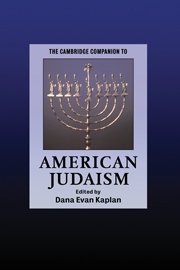Afterword
The Study of American Judaism: A Look Ahead
Published online by Cambridge University Press: 28 May 2006
Summary
As the appearance of this Cambridge Companion amply demonstrates, the study of American Judaism has, at long last, come into its own. For much of the past half-century, scholars of American Jewish life neglected “religion” and focused upon the Jewish “people.” Ethnic studies and American studies supplied the field’s dominant paradigms, while religious studies, largely the province of Christians, languished in the shadows. Those who did pursue the study of the Jewish religion were, for the most part, rabbis. Trained in Classical Judaism, they examined American Judaism through the prism of Jewish texts and history, rather than through comparisons with American Protestants and Catholics. The stunning freshness of Lou Silberman’s pioneering essay in 1964 on “Judaism in the United States in the Early Nineteenth Century,” which examined the Charleston Reform Movement (1824) against the background of the rise of Unitarianism in that city, is the exception that proves the rule.
Religion is an inherently comparative subject. Unless one is familiar with at least two religious traditions, scholars like Diana Eck remind us, one cannot claim to understand even one. The best of the articles in this volume do make reference to the larger scholarship on American religion. Indeed, Jonathan Woocher’s work on “civil religion” and Rela Mintz Geffen’s study of “rites of passage” both apply to the study of Judaism concepts initially developed by scholars working in far different arenas. It is precisely this kind of cross-fertilization that the study of American Judaism demands.
- Type
- Chapter
- Information
- The Cambridge Companion to American Judaism , pp. 417 - 422Publisher: Cambridge University PressPrint publication year: 2005
- 1
- Cited by

